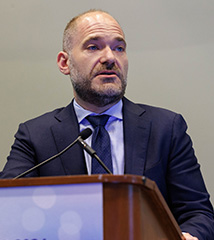

By Colton Ladbury, MD, City of Hope

For patients with relapsed/refractory large B-cell lymphoma (R/R), anti-CD19 chimeric antigen receptor T-cell (CAR T) therapy is now considered a promising treatment option when there did not used to be one. For patients with R/R LBCL, commercial CAR T-cell therapy is associated with a complete response rate (CRR) of ~50%, median overall survival (OS) in excess of 12 months, and median progression free survival (PFS) in excess of six months. While such outcomes certainly leave room for improvement, they represent dramatic progress when compared to other salvage therapies that have been used historically.
Unlike other systemic therapies, commercial CAR T-cells require an approximately one-month manufacturing period. For patients with lower disease burdens, this does not represent a problem, and the CAR T-cells can be infused once ready as the patient’s next systemic therapy. But many patients have such a disease burden that it can become acutely symptomatic and potentially life threatening if left untreated during the manufacturing period. Therefore, so-called “bridging therapies” (BT), which could include steroids, systemic therapy, and/or radiotherapy were necessitated. While initially reserved for patients with a symptom burden that required them, soon small retrospective reports from multiple institutions illustrated promising oncologic outcomes in patients (including those with no or limited symptoms) treated with bridging radiotherapy (BRT). A hypothesis emerged that radiotherapy may synergize with cellular therapies and represent a means of improving treatment response.
It was thought that BRT may offer immune augmentation, through inducing further exposure of cancer antigens to the anti-CD19 CAR T-cells, as well as cytoreduction, in which radiation is known to be associated with an excellent local response and may be particularly helpful in this population of patients who are often heavily pretreated with chemotherapy and therefore may not respond as well to systemic therapies. Although these multitude of retrospective series have shown promise, until recently BRT had not been prospectively studied, and optimal approaches still need to be elucidated.
To obtain prospective data for BRT, Imber et al. conducted a proof of principle Phase 1a trial of split-course BRT prior to commercial anti-CD19 CAR T-cell therapy for patients with R/R LBCL (NCT05574114). In this study, BRT was delivered in two phases following apheresis. First, sites that required palliation or cytoreduction before infusion received 27 Gy in 9 fractions via involved site radiation prior to lymphodepletion. Subsequently, following lymphodepletion, all metabolically active sites of disease on positron emission tomography (PET) received 3 Gy in one fraction as conditioning prior to CAR T-cell infusion.
A total of six patients were enrolled on the trial, with half having localized disease and the remaining patients having more advanced/widespread disease burden. Importantly, after receiving the BRT per protocol all patients successfully underwent subsequent CAR T-cell infusion with only one experiencing a severe toxic event, which was a grade 5 cytokine release syndrome in a patient with significant comorbidities and extensive pre-infusion disease. The anti-CD19 CAR T cells underwent strong expansion, comprising a median of 21% of all CD45+ white blood cells. All the remaining patients achieved and maintained a metabolic CR at 28- and 90-days post CAR T-cell infusion.
Per Brandon Imber, MD, “I think one of the most innovative parts of this protocol is that we are the first to report on the feasibility of delivering low dose radiotherapy after lymphodepleting chemotherapy. All other reports do it before the chemotherapy. This decision comes from preclinical data suggesting that the conditioning effects of radiation may peak in a short period after radiation delivery, so our study design was purposeful to try to capture that potential synergy. Demonstrating that this is safe may open the door to more diverse or creative combined modality lymphodepletion strategies which include radiation. We are eager to see the data mature and think there will be broad lessons for solid tumor cellular therapies as well.”
Although follow-up is still early and the sample size is limited, this study represents a promising advancement with a standardized radiation regimen, which appears to be both feasible and associated with favorable oncologic outcomes. Importantly, the BRT regimen did not appear to compromise CAR T-cell expansion. Due to these results, the study is proceeding to phase 1b with an expansion of 14 additional patients. Additional prospective data is eagerly awaited and represents a critical step in hopefully allowing radiation to return as a standard component in treatment regimens for patients with LBCL.
Abstract 256 - A Proof-of-Principle Study of Split-Course Bridging Radiotherapy (SC-BRT) prior to Commercial CAR T-Cell Therapies for Relapsed or Refractory B-Cell Lymphomas: Results from Phase 1a Pilot Cohort was presented during the SS 27 - Heme 1: Glowing Results: Clinical Trials of Radiation in Lymphoma session of the 66th ASTRO Annual Meeting.